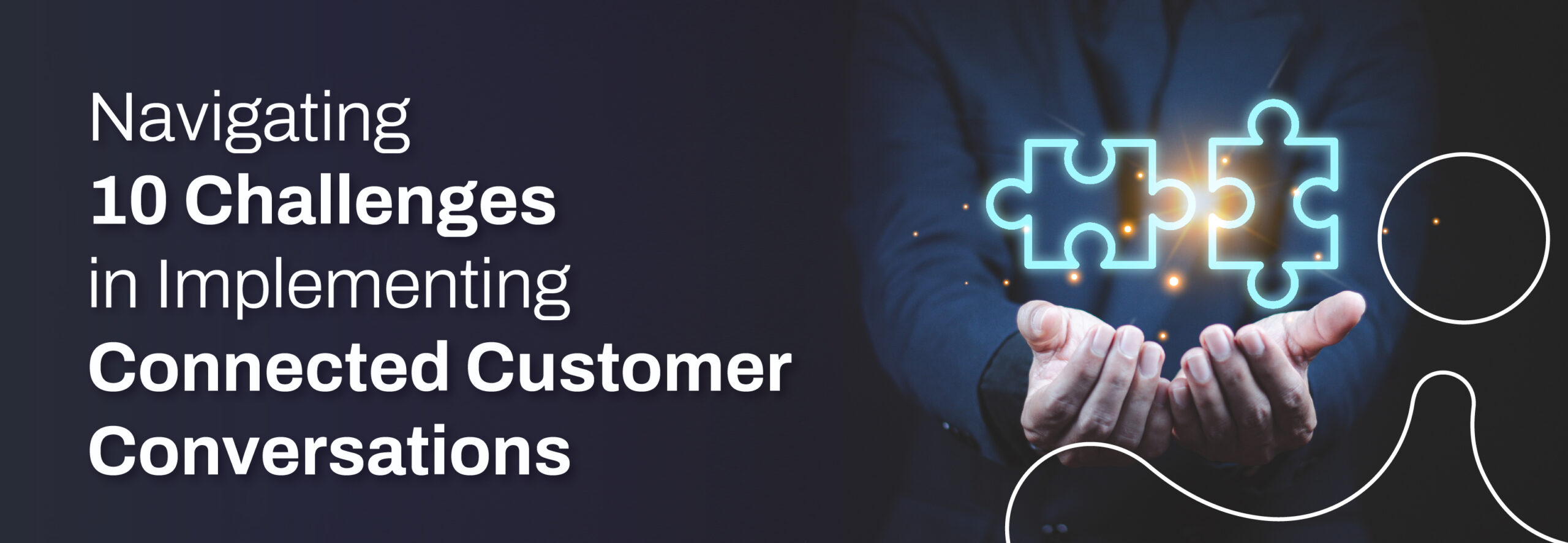Connected customer conversations refer to the seamless and integrated interactions between businesses and their customers across channels, such as phone calls, emails, live chat, social media, and more. 87% of consumers worldwide prefer such brands that connect interactions throughout their journey.
Connected customer conversations deliver personalized and engaging experiences to customers. However, businesses often encounter a range of challenges during their implementation.
Let’s delve into these challenges and explore potential solutions for each one.
1. Omnichannel Consistency
Ensuring that the branding, tonality of messaging, and overall customer experience remain consistent across channels takes time and effort. 77% of consumers feel they do not receive a cohesive experience and must repeat themselves at every touchpoint.
Overcoming this challenge requires a unified omnichannel approach to customer data management. It is crucial to align internal systems, leverage technology solutions, and implement stringent quality control processes to ensure a consistent omnichannel experience for customers.
2. Data Synchronization
Many businesses use different systems and platforms to manage customer data, such as Customer Relationship Management (CRM), Content Management Systems (CMS), and data warehouses. Integrating these systems and ensuring seamless data flow between them can be a complex task. Data synchronization requires mapping and aligning data structures, formats, and schemas.
3. Customer Privacy and Data Security
According to 55% of customers, the most crucial characteristics of a brand are trustworthiness and transparency. With data being collected, shared, and analyzed across various channels, there is an increased risk of unauthorized access, data breaches, and privacy violations. Implementing robust security measures, including encryption, access controls, and authentication mechanisms, is necessary to mitigate these risks.
4. Training and Skill Development
The main barrier to providing a great customer experience is a lack of skills and knowledge with regard to tech and data. It is thus crucial to provide regular training to employees on using technology tools, CRM systems, and customer interaction platforms. This can ensure that they efficiently handle customer inquiries, resolve issues, and maintain a high level of service quality.
5. Scalability and Customer Expectations
As businesses connect multiple channels, the volume of customer interactions can grow exponentially. Scalable solutions, such as cloud-based architectures, can provide the necessary flexibility to handle this increased scale. Additionally, businesses must stay attuned to evolving customer expectations. Implementing sophisticated customer analytics, machine learning, and AI-driven technologies can help deliver the personalization customers desire.
6. Customer Journey Mapping
Mapping the customer journey involves tracing the path customers follow as they interact with a business, from initial engagement to post-purchase support. In the case of multiple touchpoints, mapping becomes complex as it requires analyzing data from different sources. It is thus essential to align internal teams and systems to share customer data effectively to gain a comprehensive understanding of the customer journey.
7. Real-time Responsiveness
Customers expect quick and relevant responses regardless of the channel they choose to engage with a business. Handling large volumes of data in real-time thus becomes critical. Delivering prompt responses while maintaining context and continuity in customer interactions requires well-defined workflows and advanced technologies. Businesses must set efficient routing mechanisms to route customer inquiries to the right agents in a timely manner.
8. AI and Human Collaboration
AI technologies, such as chatbots and virtual assistants, can handle routine inquiries, provide instant responses, and assist customers in self-service scenarios. However, there are limitations to AI’s ability to handle emotionally charged interactions. Transitioning customers from automated interactions to human agents should be smooth and must preserve context. Businesses must design clear escalation paths and build a strong feedback loop between AI and human agents.
9. Technology Compatibility
Compatibility issues can arise when connecting legacy systems with modern communication platforms or integrating third-party applications with existing infrastructure. Such issues can result in bottlenecks, delays, or even system failures. Adopting standardized protocols, leveraging APIs and middleware, and investing in modern and flexible infrastructure can help address these challenges.
10. Cultural and Organizational Change
Moving towards a connected customer approach requires a shift in organizational mindset and culture. Existing processes and workflows must be reevaluated to align them with the connected customer strategy. For a smooth transition, businesses require a comprehensive change management plan. Moreover, commitment to a customer-centric culture must be cultivated at all organizational levels.
Way Forward
Successfully navigating these challenges requires a strategic approach as well as innovative CX solutions. Exotel is a leading connected customer conversation platform that leverages Contact Center as a Service (CCaaS), Communications Platform as a Service (CPaaS), and Conversational AI Platform (CAIP). It allows businesses to integrate voice, non-voice, contact center, and AI solutions to interact with connected customers like a friend.
 +91-808 8919 888
+91-808 8919 888 +91-808 8919 888
+91-808 8919 888 +966 135 181 912
+966 135 181 912



